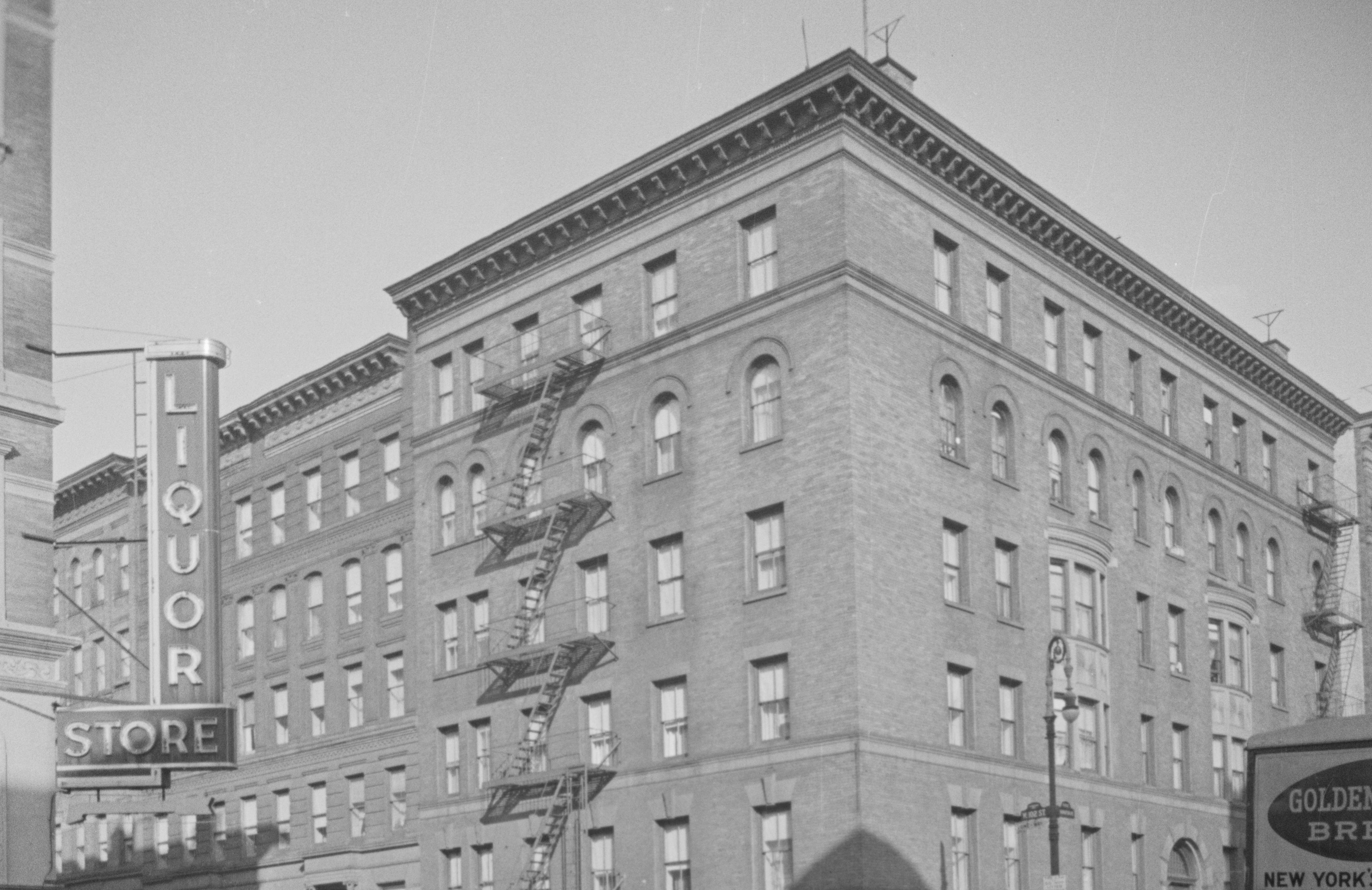
51-53 Manhattan Avenue
by Tom Miller
In 1894, architect George Keister designed two nearly back-to-back apartment buildings on the western blockfront of Manhattan Avenue between 102nd and 103rd Streets for developer Charles Buek. The southern building, completed that same year, was five stories tall and faced in beige brick above a rough-cut brownstone base. Keister’s overall Romanesque Revival design included touches of Queen Anne, seen in the sunburst panels of the slightly bowed bays at the second and third floors. The entrance, above a short stoop, was located at 51-53 Manhattan Avenue, while stores occupied the 102nd Street side.
The tenants were middle class, like Albert H. Cross, the president of the Honduras Rubber Co. and his wife. Living directly above the Crosses’ first floor apartment in 1905 was Ernest Chafee, a salesman with the silk house of Passavant & Co. and a 1902 graduated of Harvard.
According to The New York Times, the Crosses did not have children, but they did own a French poodle, “around whose neck is put a fresh pink ribbon every day.” The barking of the pampered pooch awoke Mrs. Cross at 1:30 on the morning on July 16, 1905. The newspaper said she looked around the room “to find the cause [and] saw a man crouching in the far corner of her room.” Without bothering to call for her husband, she sprang at the intruder and held him until Albert came to her aid. He held the man at the point of a revolver while Mrs. Cross called the police.
At the West 100th Street station, the man was identified as the Crosses’ upstairs neighbor, Ernest Chaffee. The Times explained, “He had left his night key in his room, he said, and had attempted to get home by way of the fire escape and the window, but had entered the wrong place.” The fact that Crosses’ apartment was on the ground floor, made the fire escape story unlikely; and the article said, “A bunch of keys was found on Chaffee, one of which fitted the front door, the police say, and would have admitted him the regular way.”
He held the man at the point of a revolver while Mrs. Cross called the police.
The case was heard on October 24. Mrs. Cross was on hand to testify, but Chaffee pleaded guilty, calling the incident a drunken accident. He told the court he had been drinking at the Harvard Club, “became confused and got into the wrong apartment.”
Despite the damning evidence against him, he was acquitted of all charges. (One wonders how neighborly the relations were between him and the Crosses afterward.)
Leon Harry Kendrick, his wife, the former Marie Louise Garrison, and their adult son, Athelstane, lived here at the time. Born in England on June 5, 1841, Leon had served in the Civil War as a first lieutenant with the 4th Massachusetts Cavalry. Athelstane, who was born in 1875, was a partner in the exporting firm of Vanderberg & Kendrick and a member of the New York Athletic Club. The 32-year-old Athelstane married Charis Leontine Carroll, the daughter of the former mayor of Syracuse, on November 16, 1907.
By 1914 the demographics of the building were changing. Among the residents that year were the R. P. Williams family, prominent in the black community. The New York Age followed their social interactions, reporting on, January 29, 1914, for instance, “John A. Kelly, the well-known undertaker of Ottoman, Va., spent the past week in New York visiting his sister, Mrs. R. P. Williams, 51 Manhattan avenue, who has been ill.” And later that year, on August 13, the newspaper announced, “R. P. Williams, 51 Manhattan avenue is spending a vacation visiting his brother-in-law, J. A. Kelly and other relatives and friends of Ottoman, Va.” As it turned out, that visit may have been somewhat of a scouting expedition. In November the Williamses moved to Ottoman, Virginia, “for their health,” according to The New York Age.
Dr. David B. Blumstein lived here at the time. At least one of his patients was an opium addict. Blumstein’s opinion was, according to his testimony before the Whitney Legislative Committee that year, “The cure of the drug habit is not a question of will power. The drug habit is a disease. No patient could will himself free from the terrible suffering he undergoes when deprived of the drug.”
Blumstein prescribed his patient, who was on parole, regulated doses of opium. The patient was to appear on December 27 to be released from parole. But a week before the hearing, when he entered City Hall, the man “was robbed of his drugs and beaten by a detective,” according to Blumstein’s testimony later. The parole officer had met him at the door of the chamber, took him into a washroom, and there the detective assaulted him, took his drugs, his hypodermic needle and the doctor’s certificate permitting him to possess the drug.
An enraged Dr. Blumstein lambasted the parole board and law enforcement in his testimony before the Whitney Committee on December 20.
One of the stores on the 102nd Street side was a delicatessen run by Samuel Pinsky and his wife. At 9:00 on the night of September 15, 1921, two well dressed young men came in and asked for lemon soda. When Pinsky turned to get the bottles, he was ordered, “Hands up, both of you!” One of the two brandished a pistol, pointing it back and forth between Pinsky and his wife while the other went to the register and took all the cash–about $100.
The New York Times reported, “The Pinskys started to weep and beg the pair not to take the money.”
“Gentlemen, don’t rob us,” Pinsky said. “We’re only poor people like yourselves, and we need it more than you do. Let us alone, please. Don’t take it all, anyway.”
The gunman responded, “Shut up! We want the money and this gun is loaded.”
The parole officer had met him at the door of the chamber, took him into a washroom, and there the detective assaulted him, took his drugs, his hypodermic needle and the doctor’s certificate permitting him to possess the drug.
So, the Pinskys remained silent until the pair fled into the street. The couple was right behind, yelling, “Stop, thief!” The crowd of pedestrians outside chased after the fugitives and soon a policeman joined the pursuit. The robbers split off in separate directions, and Officer Charles Cusack captured one of them as he fled into a building. The other ran past off-duty patrolman Peter Mescall who was walking his dog. Mescall caught him at 103rd Street and Central Park West. After a tussle, the crook escaped, but a shot from Mescall’s revolver fired over his head stopped him.
In the third quarter of 20th century, 51-53 Manhattan Avenue became part of the Douglass Houses complex. One-Hundred-and-Second Street, where the Pinskys’ deli had been, was closed off and the storefronts closed up. Sadly, an article in The Spirit on October 17, 2014 detailed the “deplorable conditions” within the apartments. “At 51-53 Manhattan Avenue, residents say a bedbug infestation has reached crisis proportions and that they need to be relocated,” said the article.
Despite the changes inside, the exterior of George Keister’s handsome building is relatively unchanged after 130 years.
Tom Miller is a social historian and blogger at daytoninmanhattan.blogspot.com


